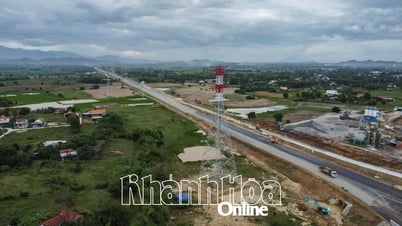On the afternoon of May 1, Mr. Nguyen Duc Hoa, Deputy Head of the Climate Forecast Department, National Center for Hydro-Meteorological Forecasting, said that in April, in the Northwest region of the North and the provinces from Thanh Hoa to Phu Yen, there were 3 heat waves and severe heat waves, some places were especially severe.
Notably, the heat wave from April 26-30 appeared in the entire North and Central regions. This is also the time when people enter the April 30-May 1 holiday. At this time, the Northwestern provinces of the North and from Thanh Hoa - Phu Yen are extremely hot and especially extremely hot with common temperatures of 39-42 degrees, in the Central region, some places are over 43 degrees.
In the Central Highlands and the South, there has been heat and severe heat lasting for the past month.
According to Mr. Hoa, in the recorded month, many stations had the highest daily temperature value exceeding the historical value (GTLS) of the same period and in some places even higher than the highest value ever observed in the year. There were even stations measuring higher than the previous GTLS of 10-20 years.
Specifically, on April 27 in Hanoi: Lang station recorded a temperature of 41.5 degrees, exceeding the GTLS of 39 degrees 18 years ago (2006); Son Tay station recorded 40.4 degrees, exceeding the 37.8 degrees (1998) or Ha Dong 40.5 degrees, exceeding the 37.2 degrees (2015),... On the same day, in Phu Ly (Ha Nam) recorded a temperature of 41.8 degrees, exceeding the GTLS of 38.9 degrees 58 years ago.
On April 28, a series of places also recorded temperatures exceeding the GTLS of the same period, such as Dong Ha (Quang Tri) 44 degrees, exceeding 42.1 degrees (in 1980); Lac Son (Hoa Binh) 42 degrees, exceeding 40.7 degrees (in 2012),...

Notably, Dong Ha (Quang Tri) and Tuong Duong (Nghe An) recorded the highest temperature of 44 degrees Celsius on April 28 and 30, respectively. This temperature is only 0.2 degrees lower than the record temperature of 44.2 degrees Celsius recorded in Tuong Duong on May 7, 2023.
According to the meteorological agency, the average temperature in the Northern, North Central and Central regions this month is 2-4 degrees higher, some places are over 4 degrees. Other regions are generally 1-3 degrees higher, with some places in the Central Highlands being 3 degrees higher than the average for the same period.
Notably, in April, alternating with heat waves, there were many thunderstorms, tornadoes, lightning and hail across the country, concentrated mainly in the northern provinces.
The North is hotter and rainier
Commenting on the climate trend in May, expert Nguyen Duc Hoa said that the average temperature across the country was generally 1.5-2.5 degrees higher than the average, and in some places higher than the average for the same period.
Total rainfall in the month in the Northeast region is 5-20% higher, in which some places in the Northeast region have 25-30% higher rainfall than the average. In the Northwest region, it is 5-15% lower, other regions across the country are generally 20-40% lower than the average for the same period.
During the forecast period, the low pressure in the west continues to be active, so in the Northern region, the provinces from Thanh Hoa to Phu Yen will experience many hot and extremely hot days, with some places experiencing especially intense heat.
The Central Highlands and the South continue to experience many days of widespread heat, with some places experiencing severe heat, concentrated in the first 20 days of the month.
"The phenomenon of heat waves and severe heat waves across the country is forecast to appear more frequently than the average of the same period," Mr. Hoa commented.
In addition, thunderstorms in the Northern region tend to increase gradually during the forecast period. In addition, in the last 10 days of May, the Southwest monsoon in the South tends to become stronger, so rain is likely to increase in the Central Highlands and the South.
Mr. Hoa warned that nationwide, it is necessary to continue to guard against dangerous weather phenomena such as thunderstorms with tornadoes, lightning, hail and strong gusts of wind.
Head of the Weather Forecast Department Nguyen Van Huong added that it is difficult to predict thunderstorms, tornadoes, and hail in the long term, but early warnings can be given through monitoring devices such as satellite cloud images and radar images with high response; from there, warnings can be given about 30 minutes to 1 hour in advance.
Source


![[Photo] General Secretary concludes visit to Azerbaijan, departs for visit to Russian Federation](https://vphoto.vietnam.vn/thumb/1200x675/vietnam/resource/IMAGE/2025/5/8/7a135ad280314b66917ad278ce0e26fa)
![[Photo] General Secretary To Lam begins official visit to Russia and attends the 80th Anniversary of Victory over Fascism](https://vphoto.vietnam.vn/thumb/1200x675/vietnam/resource/IMAGE/2025/5/8/5d2566d7f67d4a1e9b88bc677831ec9d)
![[Photo] Prime Minister Pham Minh Chinh meets with the Policy Advisory Council on Private Economic Development](https://vphoto.vietnam.vn/thumb/1200x675/vietnam/resource/IMAGE/2025/5/8/387da60b85cc489ab2aed8442fc3b14a)

![[Photo] National Assembly Chairman Tran Thanh Man chairs the meeting of the Subcommittee on Documents of the First National Assembly Party Congress](https://vphoto.vietnam.vn/thumb/1200x675/vietnam/resource/IMAGE/2025/5/8/72b19a73d94a4affab411fd8c87f4f8d)
![[Photo] President Luong Cuong presents the decision to appoint Deputy Head of the Office of the President](https://vphoto.vietnam.vn/thumb/1200x675/vietnam/resource/IMAGE/2025/5/8/501f8ee192f3476ab9f7579c57b423ad)























































![[Photo] Prime Minister Pham Minh Chinh talks on the phone with Singaporean Prime Minister Lawrence Wong](https://vphoto.vietnam.vn/thumb/402x226/vietnam/resource/IMAGE/2025/5/8/e2eab082d9bc4fc4a360b28fa0ab94de)
































Comment (0)